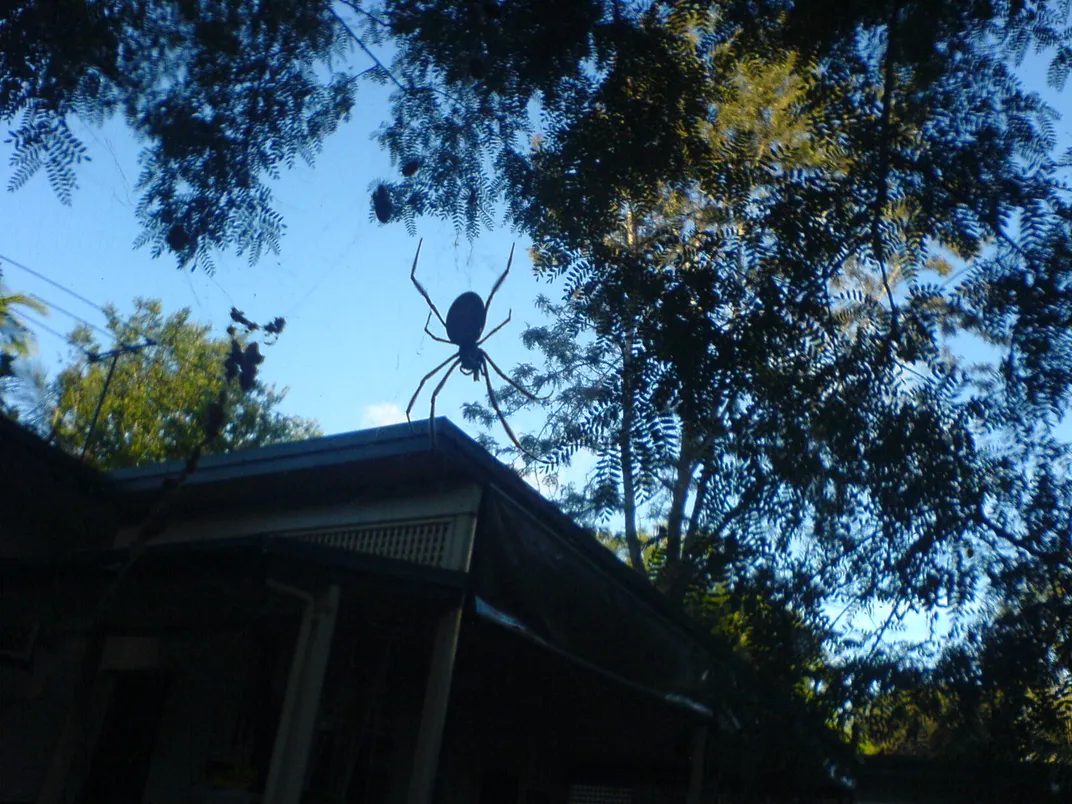Friendly Neighborhood Spiders Get Bigger in Cities
A study of orb-weaving spiders in Australia shows a correlation between urbanization and fatter arachnids
/https://tf-cmsv2-smithsonianmag-media.s3.amazonaws.com/filer/ff/3f/ff3f59a0-910f-4ac2-87b9-3a9ae32f860a/urbanspidermanedit.jpg)
This is no comic book movie plot: Urban ecology data suggests that at least some types of spiders get bigger when they live in cities.
A team of researchers from the University of Sydney sampled spiders across their home city and found that Nephila plumipes, a type of golden orb-weaving spider, is larger and carries more eggs when it lives in more urbanized areas.
“We found associations with size and hard surfaces and lack of vegetation,” explains Lizzy Lowe, a graduate student in ecology and lead author on the study. Lowe first suggested that cities might be supersizing spiders at a meeting of the Ecological Society of Australia in 2012, and the final results of this research appear in PLOS ONE today.
As cities encroach on the natural environment, many wild organisms suffer, and urbanization often comes with a significant drop in biodiversity or worrisome shifts in animal behavior. Some species just can’t hack it, but others thrive in the urban jungle. In Sydney, the largest city in Australia, golden orb-weaving spiders are common in the Royal Botanical Gardens and other urban oases. “They are abundant in urban Sydney, and I was interested to find out why,” says Lowe.
Lowe and her colleagues searched for golden orb-weaving spiders in 20 sites around Sydney with varying degrees of urbanization—parks, bush patches and forested areas. Capturing 222 spiders in total, they measured each spider’s front leg and weight to gauge size. To look at fertility specifically, they also measured the ovary and fat storage weight in 29 spiders spanning the different sites.
Lowe then calculated degrees of urbanization around where the spiders were found. Her team looked at the amount of vegetation covering the land, distance from the city center and even socioeconomic information such as income and population density. Overlaying all of this data with the spider measurements, she began looking for patterns.
Lowe and her colleagues found that overall, larger spiders with more eggs lived in more urbanized spaces with less vegetation and more hard surfaces, such as sidewalks and concrete walls. “These surfaces retain heat, leading to the urban heat island effect,” says Lowe. This increase in temperature could mean the spiders spend less energy keeping warm, helping them grow.
It’s also possible the spiders are getting fat because they have more to eat. Large spiders were frequently found on or around light posts and other manmade objects. Especially at night, artificial light could attract a smorgasbord of beetles, flies and moths for the orb-weaving spiders to munch on. Large spiders with bigger ovaries were also found in densely populated, wealthy suburbs. The researchers suggest that these areas might produce more trash for spider prey to eat, or healthier parks and green spaces for prey to inhabit. Either way, the spiders get better food options.
Urban orb-weaving spiders also might encounter fewer predators and parasites, like wasps and other spiders. Smaller dewdrop spiders steal prey and even entire webs from golden orb-weaving spiders, and the team found fewer of these “kleptoparasites” in webs from more urbanized regions.
Every spider species is a bit different when it comes to foraging strategies, diet and behavior, and some may not thrive in the city. “Organismal ecology is rarely a one-size-fits-all discipline,” says Chad Johnson, an ecologist at Arizona State University. For instance, cities could destroy hunting grounds for non-weavers such as wolf spiders, which rely on subtle vibrations in soil or water to find prey.
It also depends on the habitat that’s being urbanized. “Urbanizing a desert has very different effects compared to urbanizing a prairie or a temperate forest—and this variation will likely affect different species differently,” says Johnson.
In 2012, Johnson’s lab found that urban black widows had fewer eggs than their desert brethren. In that study, though, the team only compared one site in the desert to one site in the city. Unpublished data looking at eight sites apiece shows a trend more consistent with the orb-weavers: spiders with more eggs in urban areas.
So are we in for a city spider explosion? Unlikely. On the plus side, these spiders will keep populations of other critters in check, but they might hit a tipping point themselves. Running out of food could cause a population crash, and if things get too warm as the climate changes, the spiders may not be able to handle the heat. Or perhaps the wealth of spiders will attract new arachnid predators.
“As the density of urban spiders grows, it is likely that other species will begin to exploit this abundance,” says Johnson. Given recent interest in insect cuisine, that other species might even be us.
/https://tf-cmsv2-smithsonianmag-media.s3.amazonaws.com/accounts/headshot/Screen_Shot_2014-01-27_at_12.05.16_PM.png)


/https://tf-cmsv2-smithsonianmag-media.s3.amazonaws.com/filer/8e/4a/8e4ac065-fac4-4dfc-8f2c-64a177ff5a3b/415981220_2f656b6f5b_o.jpg)
/https://tf-cmsv2-smithsonianmag-media.s3.amazonaws.com/filer/36/77/3677e25c-446e-4761-a1c4-c6b9efcae303/3375426076_d577834bab_o.jpg)
/https://tf-cmsv2-smithsonianmag-media.s3.amazonaws.com/filer/23/4f/234fd5c7-414a-4baf-bff8-b98215405fb3/5757617478_2f9f8c6d5c_o.jpg)
/https://tf-cmsv2-smithsonianmag-media.s3.amazonaws.com/accounts/headshot/Screen_Shot_2014-01-27_at_12.05.16_PM.png)